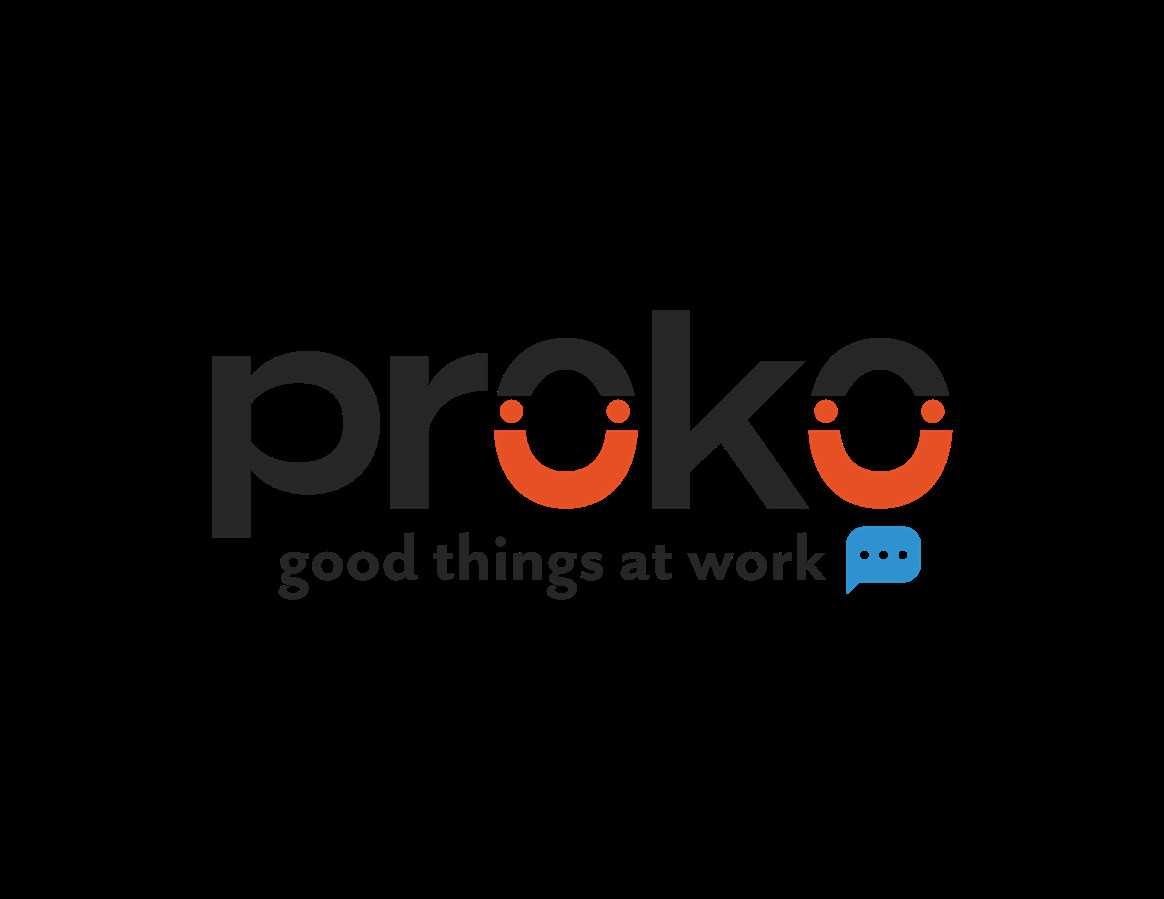
11 minute read
Proko’s Guide to Positivity in the Workplace

Contents
Advertisement
Page 3
Introduction
Page 4
What Does a Positive Culture Entail?
Page 10

Five Steps To Building a Positive Workplace Culture
Page 18
Conclusion
Page 20
More About Proko

Introduction
According to Achievers’ study, 20.8% of employees say that they are actively engaged at work, while 16.3% are fully disengaged, and 31.3% feel that they’re engaged but their organization should do more to enhance employee experience.
In order to get more of your employees engaged, you need to create a culture of positivity. Fostering a positive culture increases motivation, improves attainment, and reduces the costs that would typically be associated with high turnover. All of which are critical to the success of your organization.

This guide dives into what a positive culture entails and its benefits, and lays out the steps organizations need to take in order to achieve it.

What Does a Positive Culture Entail?

Workplace cultures are the shared values, belief systems, attitudes and assumptions that employees share. A positive culture is an environment where those values, belief systems, attitudes, and assumptions allow employees to feel respected, valued, and supported. Below are just some of the many factors that attribute to a positive working culture.
Open communication and dialogue regarding your company’s vision, mission, and values both in the long-term and in the short term. Strong leadership that values their employees and treats them with respect. Career development programs that allow employees to expand their skill set and/or transition into another function or role. The acknowledgement of important projects and milestones, and personal life events. Policies and programs that promote diversity and inclusion and zero tolerance when it comes to harassment and bullying.
The Benefits
of Positivity in the Workplace
It’s become all too easy for your employees to look at the glass half empty. For some, work may be stressful, frustrating or just plain boring. Others might be losing sight of the bigger picture, and need to reconnect with things they are grateful for and enjoy about their job.
We’ve long heard about the power of positive thinking and if you go deeper into the science, the evidence is startlingly clear: a positive attitude in the workplace benefits everyone. Here’s how.

Enhanced Health
Researchers have found that positive thinking can contribute to an increased life span, lower rates of mental illness, better cardiovascular health, greater coping and stress management skills, and more. While these benefits seem very individual, their impact can affect your entire workforce. Positivity is healthy and contagious. The more positive attitudes and behaviors are encouraged, the better off your organization will be.
Your business can take it a step further by investing in and promoting wellness programs. Any positive initiatives that focus on physical and mental health will not only influence positive behaviors, but it will show that you appreciate your staff and care about their well-being. Adding a little healthy competition is even better, as the reward will not only benefit them in the short-term, but in the long run as well.

More Career Development Opportunities
Positivity often leads to more career development opportunities like online courses and off-site training events.
According to SHRM, 30% of employees considered career development opportunities for learning and personal growth in general very important, and yet only 30% were happy with their current situation.
By offering programs that will help them succeed, they will not only gain skills that will help them excel, but they will become more connected and engaged with their work. Programs that are inclusive of everyone can also bring members of your staff that don’t typically interact together.
Better Relationships and Teamwork

According to a study from Globant, 51% of employees, regardless of job title or role, say their peers are the number one group that inspire them to stay with a company. Who wouldn’t want an environment where people work well together, and there’s no political infighting?
While it’s unrealistic to avoid negative behaviors like incivility or bullying completely, positive workplaces have policies for addressing these situations, so that they can focus on keeping teamwork and collaboration at the forefront of their culture.
In positive workplaces, people feel more open to share their experience. Through engagement surveys and polls, you can gauge the emotions and sentiments of your workforce, and help determine positive attributes and programs that can elevate their experience.

Financial Success
It’s long been proven that the biggest benefit to a positive workplace is greater financial success. Positive actions like recognition and rewards will not only influence your employee’s feelings about their workplace, but it will increase motivation, improve attainment, and reduce the costs that would typically be associated with high turnover.
Negativity can have the opposite effect. Behaviors like absenteeism, burnout, and low morale when unresolved can lead to mental health conditions like depression and anxiety, which have a significant economic impact. According to the World Health Organization (WHO), depression and anxiety can contribute to $1 trillion per year in lost productivity.
In order to see bigger and better business outcomes, you need to invest in the careers of your employees, treat them like stakeholders in their company, and give them the tools they need to do their jobs.



Whether your organization is just beginning to grow, or you’re trying to keep your current employees engaged or both, there are quite a handful of steps you need to take in order to establish and build a positive workplace culture. Below are five steps that will help you get started.
Establish and Communicate Your Values
It’s important to establish and communicate your core values with employees so that they feel connected with your organization. Values are guiding principles and beliefs that your organization adheres to in order to drive your business forward. They are often created when you’re just starting to build your business, and may change as it evolves.

Alluding to these values in the mission statement on your website is not enough; you must take demonstrable actions so that employees feel an individual responsibility towards these values. This means asking for and receiving input before, during, and after you first lay out your values. Sending out surveys and polls to understand the pulse of your organization in relation to these values will help you understand if your employees are connected with these values and if there is unreported behavior that is not matching with the principles that you’ve outlined.
Establishing and communicating your values isn’t a one time act; you must reinforce the message in different ways so that your employees can continue to feel inspired by them. This is especially the case if your values change, even slightly, as your employees are constantly reevaluating why they are working for your organization. It doesn’t hurt to remind them of the pride they feel towards your organization as well.
Express Appreciation
According to a TINYpulse report, 21.5% of workers who don’t feel recognized for their hard work in an organization have been looking for a new job in the past three months, as opposed to 12.4% of workers who do feel recognized. In order to build a positive corporate culture, you need to put recognition and appreciation at the forefront. You can achieve it by:
• Using internal communication channels to express appreciation for team achievements and individual hard work. • Giving constructive feedback to employees that will motivate them to improve. • Celebrating business successes with the entire workforce. • Finding ways to develop your employees’ strengths.
Employees who know that their efforts will be rewarded and appreciated tend to innovate more often and work harder. Feeling a direct link

between business success and their work adds meaning to what they are doing. Everyone feels engaged when they feel their hard work is recognized.

Foster Open Communication and Collaboration
Your employees feel more confident when you encourage open communication and collaboration. Open and honest communication will help build trust with your employees, and they will in turn feel comfortable sharing their feedback and experiences with you. This type of commentary typically shared in surveys and polls will help you audit the engagement levels of your employees, and will allow you to create antibullying policies and complaint procedures that work best for everyone.
Encouraging open communication also leads to a virtuous circle of engagement and advocacy. Employees buying into the culture of transparency and authenticity are more willing to advocate for their brand.
In addition to building trust and advocacy, having an open and

collaborative environment will motivate employees to build relationships with their peers both inside and outside of work. Encouraging employees to get to know the peers they do and do not interact with often will not only help them better understand how your organization works, but will make them feel comfortable interacting outside of work.
Support Your Employees
Employees who feel supported, cared for and trusted are more engaged and they naturally bring their best to the business. That’s why organizations need a corporate culture where employees feel cared for. You can cultivate a culture of support by:
• Setting up internal support systems like workshops, career mentoring and gift giving programs for employees who are going through transitions at work or in their personal lives. • Keeping people accountable and available to help each other get complex tasks done smoothly. • Encouraging managers to schedule face-to-face meetings and prioritizing activities to strengthen
human connections with employees. • Implementing internal communication channels where employees can announce their individual and team achievements.



Create Clear Goals and Rewards for Employees

Motivated and engaged employees are made if they are treated equally and have clear professional goals that they can work towards. Continuing the performance dialogue outside of the formal review process will give your staff the opportunity to consistently reflect, evaluate, and measure their own performance.
In addition, identifying measurable performance indicators for your organization as a whole can help you promote healthy competition and collaboration, and will show your employees that their individual contributions are valuable to your business.
Recognition and rewards can come in a myriad of ways, but it’s what your employees consider most important when making the decision to leave or stay in their job. Having a clear transparent program for promotions and other rewards is key in motivating them to go above and beyond.
Conclusion
Sometimes we need to remind ourselves about the very things that attracted us to our jobs in the first place or remember the things and people that we’re grateful for. Positive thoughts create real value in life, especially in the workplace. A positive mindset is healthy and contagious, and it benefits everyone. It fosters an environment where employees are happy and engaged, which leads to better business outcomes.

A positive culture in the workplace is required for fostering a sense of pride and ownership among employees. People invest their future in the organization and work hard to create opportunities that also benefits the organization. By rewarding those employees, other team members will be encouraged to contribute in the same ways, ultimately resulting in a positive work place culture. A community of encouraged employees, in turn, produces endless benefits to the organization.

More About Proko

Proko is the social platform that allows anyone to share the best things about their work and workplace. Combining the benefits of employee engagement, recognition, rewards, referral, and recruitment marketing, Proko’s digital platform encourages storytelling and affords an easy way to share good things about your culture and the people that are making work great.
Contact Us: positivity@proko.co


